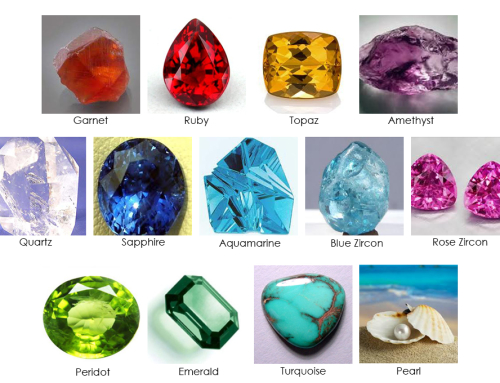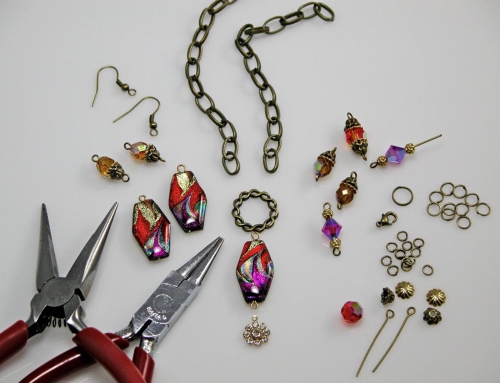Jewelry can be as questionable on how to clean as your delicate garments, so it is important to know the proper way to care for each item. It is important to evaluate which method of cleaning is appropriate for each jewelry based on the metals and gems that it is made of. I will cover how to clean jewelry with gems, pearls and precious metals. Some fashion jewelry also known as costume jewelry is of such high quality, it looks almost as good as the real thing. But because it’s not the real thing, it probably contains faux gemstones, plated metals, glue and painted surfaces, all of which require special care to avoid damage and keep them looking new.
Avoid:
Never apply acidic cleaners like vinegar or baking soda to fashion jewelry. These can pit the metal and discolor the stones. Also avoid harsh, ammonia-based cleaners. Ultrasonic cleaning machines that soak the jewelry in a special solution may damage it as well.
Remove your jewelry when:
- Cleaning the house or using harsh chemicals.
- Putting on lotion, perfume, hairspray, shaving cream and other beauty products.
- Doing laundry.
- Swimming in the pool.
- Experiencing extreme cold or heat-especially one right after the other.
To clean your fine jewelry:
- Use warm water and mild soap
- Rinse
- Polish with a soft cloth
- Dry your jewelry before storage
- Both gold and silver can tarnish from it and water can leave residual water stains on your precious metals.
Store jewelry carefully, following instructions when provided. Try not to let the pieces touch to avoid scratching. If your jewelry comes with its own pouch or box, use it. Some jewelry and gemstones come with special care instructions. Follow them to the letter.
Special care for special stones:
Emerald:
Emeralds are durable, but their internal characteristics require some special care. They can be soaked and brushed briefly with cool water. We don’t recommend extreme heat, hot water, steamers or ultrasonic cleaners. Don’t expose to harsh cleaning solutions.
Fashion Jewelry:
Jeweler cement is often used to create fashion jewelry, and special precautions should be take when cleaning these pieces. Wipe with a damp cloth and dry with a soft, clean cloth. Ensure that your jewelry is completely dry. Avoid soaking in water or using heat, steamers or ultrasonic cleaners. Don’t use jewelry cleaners or other chemicals.
Jade:
Wipe gently with a damp cloth. Dry thoroughly with a soft cloth. Avoid hot water, chemicals, steamers and ultrasonic cleaners. Don’t soak.
Lapis Lazulli:
Avoid hot water, but mix mild soap and cool water. Wash only as needed and rinse quickly with cool water. Dry thoroughly. Avoid steamers, ultrasonic cleaners and soaking.
Marcasite:
Jeweler cement is occasionally used in setting marcasite. For cleaning stones, wipe gently with a damp cloth.
Dry thoroughly with a soft cloth. Avoid hot water, soaking, chemicals, steamers and ultrasonic cleaners.
Opals:
Soak briefly in cool water. Dry thoroughly with a soft cloth. Avoid extreme heat, water, steamers or ultrasonic cleaners.
The Pearl World:
Wipe your pearls with a damp cloth to remove perspiration, oil or any other residue. For regular cleaning, wipe with a damp cloth. Dry completely with a soft cloth. Avoid heat, hot water, steamers or ultrasonic cleaners along with cosmetics and hairsprays. Don’t soak in water.
Turquoise:
Wipe gently with a damp cloth. Dry thoroughly with a soft cloth. Avoid hot water, soaking, chemicals, steamers or ultrasonic cleansers
Rhinestones:
Rhinestones’ glitter comes from foil backing behind the stones, and some rhinestones are better made than others. If the backing tarnishes, it will make the stones appear black or dull, and there’s nothing you can do about it. Because many rhinestones are glued to the foil backing, clean them using as little liquid as possible. Moisture can discolor the foil and loosen the glue, causing stones to fall out. If dry cleaning with a soft brush doesn’t do the trick, moisten the brush or a cotton swab with just a drop of Windex glass cleaner (with no ammonia), and gently wipe each stone. The goal is to remove body oils and dust. There’s no way to polish the foil backing to restore the stone’s shine.
Coral:
Coral is not a gemstone like those mined on land, but a gift of calcium carbonate from the ocean that has been prized since ancient times. It consists of the skeletons of millions of tiny sea creatures called polyps that accumulate and form reefs over thousands of years in shallow waters worldwide. Chunks of this opaque substance are cut and polished to resemble gemstones.
- Hardness: Coral is brittle and ranks only 3.5 on the 10-point Mohs scale that jewelers use to rate a stone’s hardness and scratch resistance. Compared to a diamond, the hardest gem with a ranking of 10, coral is quite fragile.
- Cleaning: Ironically, coral will be damaged if you soak it in liquid because it is very porous. Instead of immersing coral in water or any cleaning solution, dampen a soft, clean cloth with water only (no soap) and wipe the coral gently. If the piece has a metal setting that must be polished, be careful not to touch the coral with the polish. After cleaning, let the coral thoroughly air-dry before storing. Never use hot water or an ultrasonic jewelry cleaner on coral.
- Care: Apply makeup, perfume and hairspray before you put on coral jewelry because those chemicals can discolor or destroy it. Do not leave coral jewelry in the heat or wear it in water, such as when washing dishes or swimming. Water dulls the finish, and chlorinated water can ruin it. Store coral in a separate cloth bag or in a cloth-lined jewelry case to keep it from getting scratched. If your coral gets dull, a jeweler can polish it and restore its luster.
- Colors: Rich red coral mainly comes from the coast of Italy in the Mediterranean or near Japan. Pink and gold corals grow near Hawaii. Black coral also comes from Hawaii, as well as the Persian Gulf and the Mediterranean. Blue coral is found off the coast of Cameroon. The deeper the water in which coral breeds, the more intense the color.
Other types of gems to clean and care:
Alexandrite:
Clean with soapy water, alcohol or commercially available products. You can also use mechanical cleaners.
Aquamarine:
Do not use chemical cleaners. Avoid heat and frequent cleanings. Simply use soapy water.
Diamond:
While mechanical and chemical cleaners are generally safe, avoid these if your stone is fracture filled or has fractures. Always rinse and dry well when using soapy water.
Emerald:
Do not use chemical or mechanical cleaners. These methods dissolve the oils used during processing of emerald to fill inclusions. Clean with soapy water and have your jeweler re-oil your emeralds annually.
Garnet:
The safest method is to simply use a soapy water solution.
Jade:
While a soapy water solution is the easiest and safest cleaning solution, mechanical cleaners are also OK for jade. Do not use chemical cleaners.
Opal:
Wipe after use with a soft dry or slightly damp cloth. Never wash or scrub your opals.
Peridot:
Do not use mechanical or chemical cleaners. Simply use a soapy water solution.
Ruby:
Use soapy water solutions or commercially available cleaning solvents. While mechanical cleaners are generally safe, avoid these if your stone is heavily included.
Sapphire:
Use soapy water solutions or commercially available cleaning solvents. While mechanical cleaners are generally safe, avoid these if your stone is heavily included.
Spinel:
Use soapy water solutions or commercially available cleaning solvents. While mechanical cleaners are generally safe, avoid these if your stone is heavily included.
Tanzanite:
Never use mechanical or chemical cleaners. Simply use a soapy water solution.
Topaz:
Never use mechanical or chemical cleaners. Simply use a soapy water solution.
Tourmaline:
Never use mechanical or chemical cleaners. Simply use a soapy water solution.





Leave A Comment